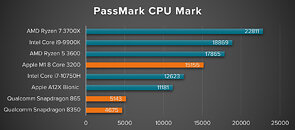
AMD Ryzen 5 9600 Nearly Matches 9600X in Early Benchmarks
The AMD Ryzen 5 9600 launched recently as a slightly more affordable variant of the popular Ryzen 5 9600X. Despite launching over a month ago, the 9600 still appears rather difficult to track down in retail stores. However, a recent PassMark benchmark has provided some insights as to the performance of the non-X variant of AMD's six-core Zen 5 budget CPU. Unsurprisingly, the Ryzen 5 9600X and the Ryzen 5 9600 are neck-and-neck, with the 9600X scraping past its non-X counterpart by a mere 2.2% in the CPU benchmark.
According to the PassMark result, the Ryzen 5 9600 scored 29,369, compared to the Ryzen 5 9600X's 30,016, while single-core scores were 4581 for the 9600X and 4433 points for the 9600, representing a 3.2% disparity between the two CPUs. The result is not surprising, since the only real difference between the 9600 and the 9600X is 200 MHz boost clock. All other specifications, including TDP, core count, cache amount and base clock speed, are identical. Both CPUs are also unlocked for overclocking, and both feature AMD Precision Boost 2. While the Ryzen 5 9600 isn't available just yet, it will seemingly be a good option for those who want to stretch their budget to the absolute maximum, since recent reports indicate that it will be around $20 cheaper than the Ryzen 5 9600X, coming in at around the $250-260 mark.
According to the PassMark result, the Ryzen 5 9600 scored 29,369, compared to the Ryzen 5 9600X's 30,016, while single-core scores were 4581 for the 9600X and 4433 points for the 9600, representing a 3.2% disparity between the two CPUs. The result is not surprising, since the only real difference between the 9600 and the 9600X is 200 MHz boost clock. All other specifications, including TDP, core count, cache amount and base clock speed, are identical. Both CPUs are also unlocked for overclocking, and both feature AMD Precision Boost 2. While the Ryzen 5 9600 isn't available just yet, it will seemingly be a good option for those who want to stretch their budget to the absolute maximum, since recent reports indicate that it will be around $20 cheaper than the Ryzen 5 9600X, coming in at around the $250-260 mark.




























